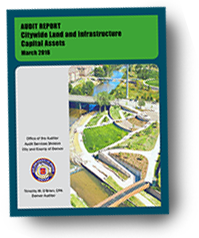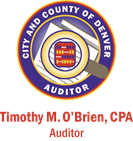Auditor Recommends Measures to Accurately Account For Parks, Other Capital Assets Mar 17, 2016
Auditor Timothy M. O’Brien, CPA, today released an audit of Denver’s land and infrastructure  capital assets. “We sought to determine whether the City’s policies and practices related to recording these capital assets allow for complete and accurate financial reporting, and to review the Parks and Recreation Department’s approach to designating official park land,” explained Auditor O’Brien.
capital assets. “We sought to determine whether the City’s policies and practices related to recording these capital assets allow for complete and accurate financial reporting, and to review the Parks and Recreation Department’s approach to designating official park land,” explained Auditor O’Brien.
Parks and Recreation (DPR) is responsible for the daily operation and management of the City’s park system. The City’s parks and open space management came under enhanced scrutiny following the 2013 transfer of part of Hentzell Park natural area to Denver Public Schools. The City Charter restricts the sale or lease of park land belonging to the City as of 1955, as well as land designated as park land after that date.
“We found that DPR had not officially adopted a 2009 draft policy outlining the process for formally designating City-owned land as park land,” Auditor O’Brien commented. “We recommended the formal adoption of such a policy to diminish uncertainty about the process of protecting this vital public asset. Once a park is designated, the City Charter forbids its sale or transfer without approval from the voters. Many park enthusiasts welcome this extra level of protection.”
Numerous park parcels added in the past 60 years never received official designation. After the Hentzell land transfer controversy, DPR has moved to designate almost 750 acres of land that had not previously been designated. Currently, almost 70% of the urban land managed by DPR has been designated as a park. Forty-two separate parcels were designated between April of 2013 and November of 2015.
As a result of the audit, DPR Deputy Executive Director Scott Gilmore agreed to formally adopt a designation policy by October, 2016, after consultation with the City’s Policy Review Committee, the DPR Parks Designation Committee, the Parks Committee of Inter-Neighborhood Cooperation, and the Parks and Recreation Advisory Board.
The City Charter also makes DPR responsible for managing all real property bequeathed for the purpose of the creation, improvement or ornamentation of any park, boulevard, pleasure way, parkway or recreational facility or for the establishment or maintenance therein of museums, zoological and other gardens, collections of natural history, observatories, or recreational facilities.
“Of the City’s capital assets, land is one of the most important and visible,” said Audit Division Director Kip Memmott. “We found one case where the City accepted donated land without going through the established administrative process, including approval by the Mayor and City Council beforehand. This is important because the City may not want land that requires substantial environmental remediation, or lacks the resources to maintain the property.” Parks Deputy Gilmore agreed to clarify the process by June, 2016.
The audit also addressed other topics, including the recording and depreciation of infrastructure assets like traffic signals.
As of 2014, the last audited year, capital assets totaled approximately $4.6 billion, with approximately $293 million in land (not including buildings).
Here is a PDF of the complete audit report.
Urban Parks Inventory with Designation Status
This map includes all open space that is designated or partially designated, according to Denver Parks and Recreation GIS records. This map does not include every open space or parkway that is not designated. For a complete inventory, with acreages and years of acquisition, see the Capital Assets audit, Appendix B on page 33.
![]()




Comments
Auditor Recommends Measures to Accurately Account For Parks, Other Capital Assets Mar 17, 2016 — No Comments
HTML tags allowed in your comment: <a href="" title=""> <abbr title=""> <acronym title=""> <b> <blockquote cite=""> <cite> <code> <del datetime=""> <em> <i> <q cite=""> <s> <strike> <strong>